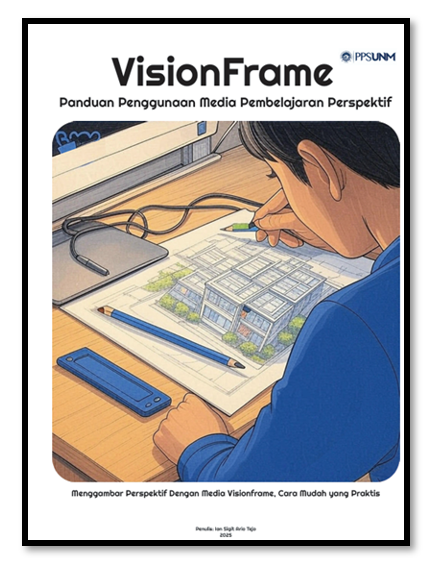Perspective Drawing Techniques with Vision Frame Media: Case Study in Art Learning at Middle School
DOI:
https://doi.org/10.51574/ijrer.v4i3.3212Keywords:
Art Learning, Drawing Techniques, Media, Middle School, Vision FrameAbstract
Perspective drawing is a fundamental skill in art education that plays a crucial role in developing visual abilities, creativity, and the understanding of three-dimensional space on a two-dimensional plane. However, many students experienced difficulties in grasping the abstract concept of perspective, particularly in determining the horizon line and vanishing points, which was attributed to the limitations of conventional learning media. Therefore, this study examined the application of the Vision Frame learning media in teaching perspective drawing techniques to students at Islamic Middle School. The research employed observation and questionnaire methods to collect data on students' perceptions of the effectiveness of Vision Frame as a visual aid in the perspective drawing learning process. This research was conducted at the Islamic Middle School (SMPIT) Darul Fikri Makassar. The data analysis techniques included both qualitative and quantitative analyses. The analysis revealed that the majority of students (75%) rated Vision Frame as highly effective in accelerating and simplifying the determination of the horizon line and vanishing points. No students provided negative feedback regarding this media. These findings indicated that the use of Vision Frame significantly enhanced students' understanding of perspective concepts, reduced technical errors, and increased their confidence in drawing. Therefore, Vision Frame was considered an innovative and effective learning medium worthy of integration into the art curriculum at the junior high school level, as demonstrated in the case study at SMPIT Darul Fikri Makassar.
References
Abdullah, M., Khairani, M. Z., Amos, F. V., Aziz, M. N. A., & Ramlie, M. K. (2024). Learning to Draw is Learning to See: A Comprehensive Review of Art and Design Practices in Higher Education. Idealogy Journal, 9(1). https://doi.org/10.24191/idealogy.v9i1.563
Apatiga, Y., & Vu, K. P. L. (2022). Comparing the effectiveness of instructor-led versus video-based learning methods for online website accessibility training. In International Conference on Human-Computer Interaction (pp. 189-206). Cham: Springer Nature Switzerland. https://doi.org/10.1007/978-3-031-22131-6_14
Aristhi, N. P. S., & Manuaba, I. B. S. (2020). Model experiential learning berbantuan media gambar terhadap keterampilan menulis puisi siswa Sekolah Dasar. Mimbar Ilmu, 25(3), 327-337. https://doi.org/10.23887/mi.v25i3.26096
Aziza, T. N., Iriaji, I., & Rini, D. R. (2024). Faktor-faktor Kendala Implementasi Kurikulum Merdeka pada Mata Pelajaran Seni Rupa Kelas VII SMP. Journal of Language Literature and Arts, 4(12), Article 12. https://doi.org/10.17977/um064v4i122024p1197-1212
Bessy, G. A. L., & Zaini, I. (2024). Teknik Grid Untuk Mempermudah Menggambar Perspektif Pada Siswa Smkn 5 Surabaya. 12(1).
Cazes, M., Noël, A., & Jamet, E. (2024). Cognitive effects of humorous drawings on learning: An eye‐tracking study. Applied Cognitive Psychology, 38(1), e4178. https://doi.org/10.1002/acp.4178
da Silva, P. R., & Palaré, O. (2023). Drawing skills at the beginning of higher education: Teachers’ perspectives, expectations, and realities. Frontiers in Education, 8. https://doi.org/10.3389/feduc.2023.1056518
D'amelio, J. (2004). Perspective drawing handbook. Courier Corporation.
Darpindo, W., & Yahya, Y. (2024). Pengembangan Media Pembelajaran Seni Budaya Materi Seni Rupa Kelas X Berbasis Flipbook di SMA Adabiah 1 Padang. Realisasi: Ilmu Pendidikan, Seni Rupa Dan Desain, 1(4), 15–28. https://doi.org/10.62383/realisasi.v1i4.303
González-Zamar, M. D., & Abad-Segura, E. (2021). Emotional creativity in art education: An exploratory analysis and research trends. International journal of environmental research and public health, 18(12), 6209. https://doi.org/10.3390/ijerph18126209
Guan, X., & Wang, K. (2022). Visual communication design using machine vision and digital media communication technology. Wireless Communications and Mobile Computing, 2022(1), 6235913. https://doi.org/10.1155/2022/6235913
Haryana, M. R. A., Warsono, S., Achjari, D., & Nahartyo, E. (2022). Virtual reality learning media with innovative learning materials to enhance individual learning outcomes based on cognitive load theory. The International Journal of Management Education, 20(3), 100657. https://doi.org/10.1016/j.ijme.2022.100657
Huang, Y., Lin, M., & Liu, X. (2024). Digital media and interactive E-learning application in art teaching process based on big data platform. Entertainment Computing, 51, 100737. https://doi.org/10.1016/j.entcom.2024.100737
Jiawei, W., & Mokmin, N. A. M. (2023). Virtual reality technology in art education with visual communication design in higher education: a systematic literature review. Education and Information Technologies, 28(11), 15125-15143. https://doi.org/10.1007/s10639-023-11845-y
Lathifah, R. R., & Hidayati, L. (2023). Pengembangan Video Tutorial Menggambar Desain Rok Secara Digital di Kelas Busana 1 SMK Negeri 2 Tuban. 5(2), 1779–1789. https://doi.org/10.31004/joe.v5i2.819
Lawrence, J. E., & Tar, U. A. (2018). Factors that influence teachers’ adoption and integration of ICT in teaching/learning process. Educational Media International, 55(1), 79-105. https://doi.org/10.1080/09523987.2018.1439712
Lee, H., & Lee, M. J. (2021). Visual art education and social-emotional learning of students in rural Kenya. International Journal of Educational Research, 108, 101781. https://doi.org/10.1016/j.ijer.2021.101781
Liu, Q., Chen, H., & Crabbe, M. (2021). Interactive study of multimedia and virtual technology in art education. International Journal of Emerging Technologies in Learning (iJET), 16(1), 80-93. https://www.learntechlib.org/p/218648/
McClure, M., Tarr, P., Thompson, C. M., & Eckhoff, A. (2017). Defining quality in visual art education for young children: Building on the position statement of the Early Childhood Art Educators. Arts Education Policy Review, 118(3), 154-163. https://doi.org/10.1080/10632913.2016.1245167
Pacheco, E., Lips, M., & Yoong, P. (2018). Transition 2.0: Digital technologies, higher education, and vision impairment. The Internet and Higher Education, 37, 1-10. https://doi.org/10.1016/j.iheduc.2017.11.001
Park, B., Korbach, A., Ginns, P., & Brünken, R. (2023). How learners use their hands for learning: An eye-tracking study. Educational Psychology Review, 35(4), 116. https://doi.org/10.1007/s10648-023-09833-2
Pavlou, V. (2020). Art technology integration: digital storytellying as a transformative pedagogy in primary education. International Journal of Art & Design Education, 39(1), 195-210. https://doi.org/10.1111/jade.12254
Purba, A. T., Purba, L. N. B., Haliza, D., Siagian, H., Simanjuntak, P. O., & Indra, E. (2024). Visual Attention Analysis of Perspective Images Using the Eye Tracking Method. Jurnal Sistem Informasi dan Ilmu Komputer, 8(1), 139-152. https://doi.org/10.34012/jurnalsisteminformasidanilmukomputer.v8i1.5133
Puspitarini, Y. D., & Hanif, M. (2019). Using learning media to increase learning motivation in elementary school. Anatolian Journal of Education, 4(2), 53-60.
Roosen, L. J., Klöckner, C. A., & Swim, J. K. (2018). Visual art as a way to communicate climate change: a psychological perspective on climate change–related art. World Art, 8(1), 85-110. https://doi.org/10.1080/21500894.2017.1375002
Rozi, F., & Zaini, I. (2024). Pengembangan Modul Gambar Perspektif Untuk Siswa Kelas X Sma Negeri I Galis Pamekasan. 12(1). https://ejournal.unesa.ac.id/index.php/va/article/view/58509
Samaniego, M., Usca, N., Salguero, J., & Quevedo, W. (2024). Creative thinking in art and design education: A systematic review. Education Sciences, 14(2), 192. https://doi.org/10.3390/educsci14020192
Suryarani, B., & Zaini, I. (2022). Pengembangan Media Pembelajaran Gambar Proyeksi Dan Perspektif Dengan Blender GamE. 10(3). https://ejournal.unesa.ac.id/index.php/va/article/view/46311
Tong, Y., Wu, J., & Zhang, X. (2021). Research on interdisciplinarity-teaching of digital media art under big data. In Journal of Physics: Conference Series (Vol. 1883, No. 1, p. 012145). IOP Publishing. https://doi.org/10.1088/1742-6596/1883/1/012145
Weng, X., Ng, O. L., & Chiu, T. K. (2023). Competency development of pre-service teachers during video-based learning: A systematic literature review and meta-analysis. Computers & Education, 199, 104790. https://doi.org/10.1016/j.compedu.2023.104790
Wiratno, T. A., & Callula, B. (2024). Transformation of beauty in digital fine arts aesthetics: An artpreneur perspective. Aptisi Transactions on Technopreneurship (ATT), 6(2), 231-241. https://doi.org/10.34306/att.v6i2.395
Xie, H., & Zhou, Z. (2024). Finger versus pencil: An eye tracking study of learning by drawing on touchscreens. Journal of computer assisted learning, 40(1), 49-64. https://doi.org/10.1111/jcal.12863
Zhang, C., & Jia, B. (2024). Enriching STEAM education with visual art: education benefits, teaching examples, and trends. Discover Education, 3(1), 247. https://doi.org/10.1007/s44217-024-00354-w

Downloads
Published
How to Cite
Issue
Section
License
Copyright (c) 2025 Ian Sigit Ario Tejo, Alimuddin Alimuddin, Andi Baetal Mukaddas

This work is licensed under a Creative Commons Attribution-ShareAlike 4.0 International License.









1.png)













